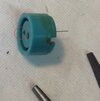Secondary Master Cylinder Rebuild- SMC
This is a job that probably all ST1300's over 5 years old need to consider. A regular addition of silicon grease into the outer boot might be excellent preventive maintenance. Forest had warned me of this problem but I really didn't understand the problem until Lynne's rear brake began locking up, enough to damage the rear disc and toast the rear piston seals. With a more thorough research of this site I was able to understand the problem. This really helped as I was able to direct the service manager as to the real problem when we took her bike in for repair under the extended warranty. The repair took three weeks but was finally completed. I felt that I needed to get mine done before my ST had similar results. I would recommend doing this job when you are replacing all the brake fluid.
Here is the front left brake caliper removed, the SMC is on the top. The push rod is on top with the bolt partly reinserted.

The manual recommends removing the entire left front caliper to work on it but I thought I might be able to rebuild it in place and avoid draining all the brake fluid. Good idea but I was not able to get the snap ring out so I took the caliper off. You will need to loosen the brake hose oil bolts before removing the caliper from the attachments to the wheel as they can be very tight.




After removing the caliper I completed removal of all the oil bolts and let the brake fluid drain into a container on the floor.

So now just to pull the boot back and take out the snap ring... It was really stuck so using a vise grip on the eye end and a 10mm wrench under the boot I just took apart the push rod assembly. Now I had direct access to the snap ring, it was still hard to remove. A good, high quality snap ring tool would be a good investment.

Now the push rod and the master piston could be removed. Note the crude and corrosion.


Cleaning out the cylinder would be hard while still attached to the brake lines
Here are the new parts and tools you will need. All the parts come in the piston set 45620-MCS-G03

Soaking the master piston and seal in brake fluid is good before installation. I also found it necessary to take apart the new push rod assembly to get the
push rod and snap ring in place, it was fairly tight.

The boot and eyelet end are easy to replace after the push rod is in place.
I put lots of silicon grease under the boot.

Now you are ready to reattach the brake lines and brake caliper. I then refilled and bled all the brake lines per the standard sequence. It did take some time to get all the air out, I did it twice. Always a circus to go through that complex sequence....
This is a job that probably all ST1300's over 5 years old need to consider. A regular addition of silicon grease into the outer boot might be excellent preventive maintenance. Forest had warned me of this problem but I really didn't understand the problem until Lynne's rear brake began locking up, enough to damage the rear disc and toast the rear piston seals. With a more thorough research of this site I was able to understand the problem. This really helped as I was able to direct the service manager as to the real problem when we took her bike in for repair under the extended warranty. The repair took three weeks but was finally completed. I felt that I needed to get mine done before my ST had similar results. I would recommend doing this job when you are replacing all the brake fluid.
Here is the front left brake caliper removed, the SMC is on the top. The push rod is on top with the bolt partly reinserted.

The manual recommends removing the entire left front caliper to work on it but I thought I might be able to rebuild it in place and avoid draining all the brake fluid. Good idea but I was not able to get the snap ring out so I took the caliper off. You will need to loosen the brake hose oil bolts before removing the caliper from the attachments to the wheel as they can be very tight.




After removing the caliper I completed removal of all the oil bolts and let the brake fluid drain into a container on the floor.

So now just to pull the boot back and take out the snap ring... It was really stuck so using a vise grip on the eye end and a 10mm wrench under the boot I just took apart the push rod assembly. Now I had direct access to the snap ring, it was still hard to remove. A good, high quality snap ring tool would be a good investment.

Now the push rod and the master piston could be removed. Note the crude and corrosion.


Cleaning out the cylinder would be hard while still attached to the brake lines
Here are the new parts and tools you will need. All the parts come in the piston set 45620-MCS-G03

Soaking the master piston and seal in brake fluid is good before installation. I also found it necessary to take apart the new push rod assembly to get the
push rod and snap ring in place, it was fairly tight.

The boot and eyelet end are easy to replace after the push rod is in place.
I put lots of silicon grease under the boot.

Now you are ready to reattach the brake lines and brake caliper. I then refilled and bled all the brake lines per the standard sequence. It did take some time to get all the air out, I did it twice. Always a circus to go through that complex sequence....
Last edited by a moderator:


















